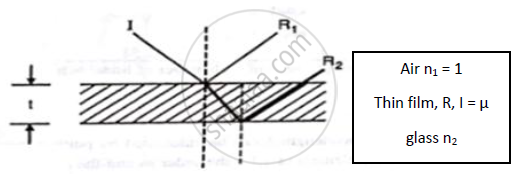Advertisements
Advertisements
Question
Describe in detail the concept of anti-reflecting film with a proper ray diagram.
Solution
1. We are aware that compound microscope, telescope, camera lenses, etc. uses a combination of lenses.
2. When the light enters the optical instrument at the glass air interface, around 4% of light that too at single reflection is lost by reflection which is highly undesirable. For advance telescopes that total loss comes out to be nearly 30% and cannot be tolerated if working under low intensity applications.
3. In order to reduce the reflection loss a transparent film of upper thickness is deposited on the surface. This film is known is “non reflecting film.”
4. Popular material uses Mgf2 because its refractive index is 1.38. cryolite is also used.
5. Thickness of the film may be obtained for given purpose as shown below:
 6. Let ray I incident up on thin film at Mgf2 coated on glass. This rays is reflected from upper surface as R1 and from lower surfaces as R2. The optical path difference between these two rays is n1(2t). as the incident ray enters from rarer to denser twice i.e at air to film and film to glass.
6. Let ray I incident up on thin film at Mgf2 coated on glass. This rays is reflected from upper surface as R1 and from lower surfaces as R2. The optical path difference between these two rays is n1(2t). as the incident ray enters from rarer to denser twice i.e at air to film and film to glass.
7. If both the rays R1 and R2 interfere with each other and path difference is (2n+1)`λ/2`, the destructive interference will take place.
∴ `2n1t=λ/2, n1t=λ/(4μ) (n=0)`
It means, in order to have destructive interference a layer of
`n_1t=λ/4` is coated on glass plate.
